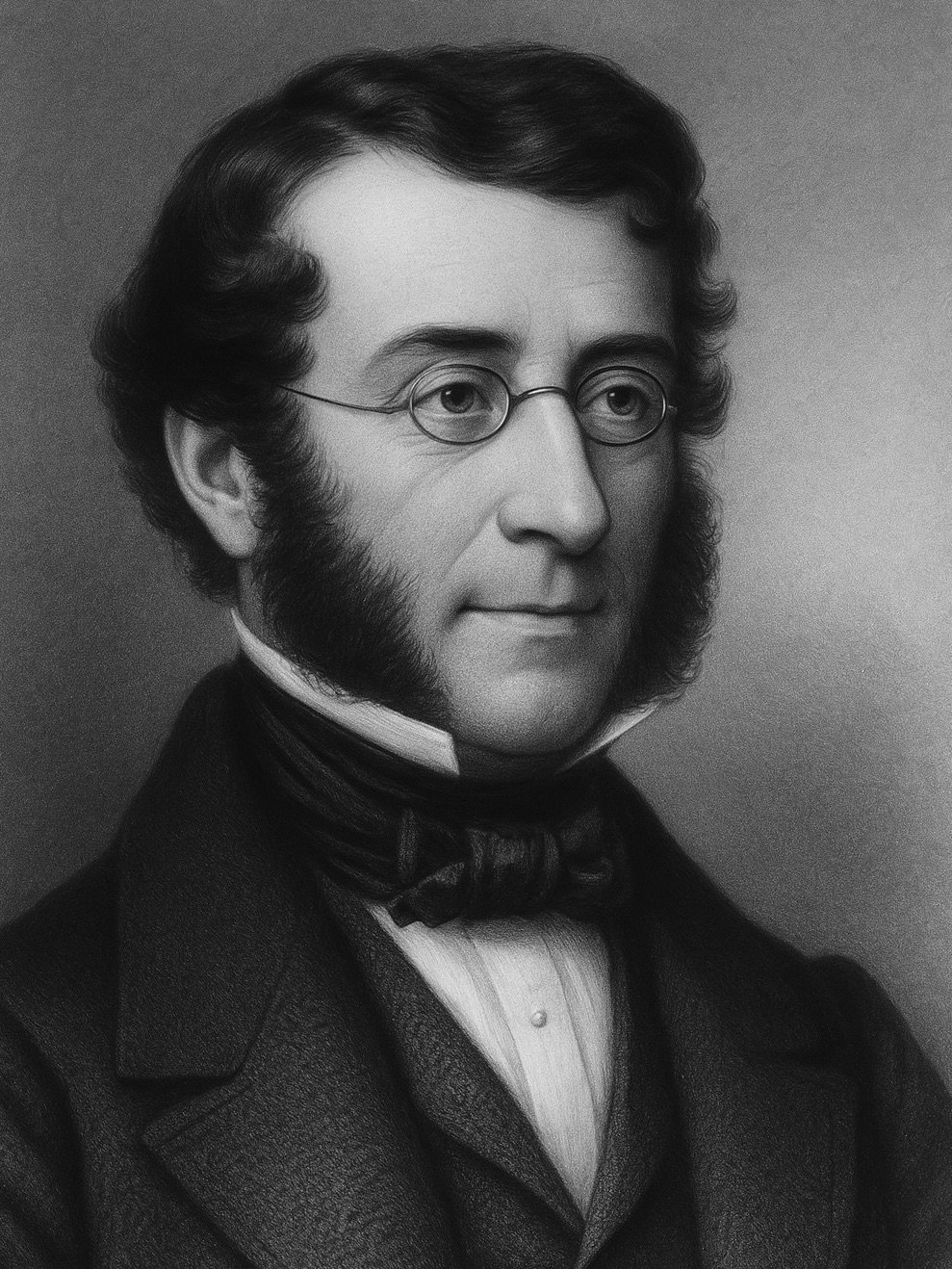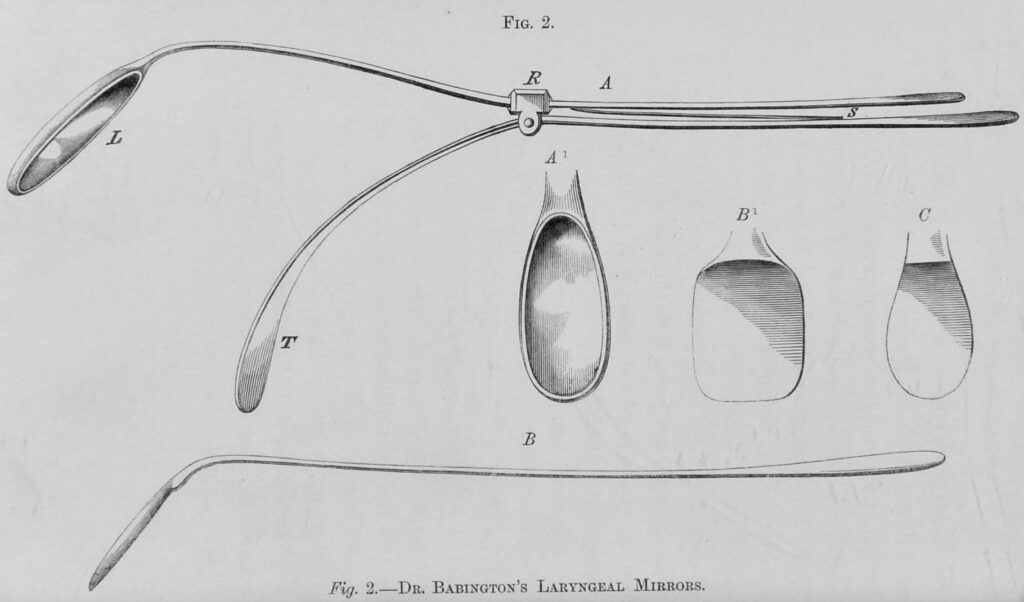Benjamin Babington

Benjamin Guy Babington (1794-1866) was an English physician and epidemiologist
Babington studied organic chemistry, then in its infancy and assisted Astley Cooper and Richard Bright in investigating diseases of the kidney by analyses of the blood and urine.
A talented linguist he translated multiple texts including Hecker’s Epidemics of the Middle Ages (1844); Feuchtersleben’s Medical Psychology (1847) and translation from Tamul of The adventures of the Gooroo Paramartan (1822)
Amongst his best known inventions was the first laryngoscope, the ‘glottiscope‘ (1829), but he also took out patents for a new design of pen (1843); a means of preventing incrusation of boilers (1850); and a facemask to protect the throat, chest, and mouth from atmospheric influences (1860)
Biography
- Born on March 5, 1794 in in Guy’s Hospital, London; son of William Babington (1756-1833), physician to Guy’s Hospital.
- Babington studied at Charterhouse School before becoming a midshipman in the Royal Navy serving at Walcheren and Copenhagen
- 1812 – East India Company College, Haileybury in preparation to join the Madras Civil Service. Earned a reputation as an oriental scholar translating various texts from Latin, Tamul and sanskrit
- 1819 – Returned to England to study medicine at Guy’s Hospital, London, and Pembroke College, Cambridge
- 1825 – MB, Guy’s Hospital, London; Fellow of the Royal Asiatic Society
- 1828 – Fellow of the Royal Society
- 1829 – Exhibited the first laryngoscope – the ‘glottiscope‘ – to the Hunterian Society of London
- 1830 – MD, Guy’s Hospital, London; elected Fellow of the College of Physicians (1831)
- 1837-1840 Assistant physician to Guy’s Hospital, ahead of Thomas Hodgkin (1798-1866)
- 1841 – Croonian Lecturer, Royal College of Physicians
- 1840-1855 Full physician to Guy’s Hospital; physician to the Deaf and Dumb Hospital. Resigned from Guy’s in 1855 following a disagreement with the hospital administration over restriction of access of students to the hospital.
- 1850 – First president and one of the founding members of the Epidemiological Society of London
- 1863 – President of the Royal Medical and Chirurgical Society
- 1865 – One of the first to describe hereditary haemorrhagic telangiectasia
- Died on April 8, 1866 in Hanover Square, London
Medical Eponyms
Despite good evidence to the contrary, the Spanish singing teacher Manuel Patricio Rodríguez García (1805-1906) is still credited by many to have been the discoverer of the mirror for inspecting the larynx in 1854.
In fact, 26 years prior to Garcia’s paper being presented to Royal Society of London, Babington had described to the Hunterian Society a similar device which had been used clinically on at least one laryngologist. Priority belongs to Babington
Glottiscope
Dr. Benjamin Babington submitted to the meeting an ingenious instrument for the examination of parts within the fauces not admitting of inspection by unaided sight It consisted of an oblong piece of looking-glass set in silver-wire, with a long shank. The reflecting portion is placed against the palate whilst the tongue is held down by a spatula, when the epiglottis and upper part of the larynx become visible in the glass. A strong light is required, and the instrument should be dipped in water so as to have a film of the fluid upon it when used, or the halitus of the breath renders it cloudy. The doctor proposed to call it the glottiscope.
Hunterian Society, 1829

Priority of publication has long been the established touchstone, by which the disputed claims of inventors have been tested. Tried by this criterion, Babington must be regarded as the inventor of the laryngoscope
Mackenzie 1865:13
Key Medical Contributions
In 1864, an anomalous exanthem was epidemic in the metropolis. Benjamin Ward Richardson (1828-1896) felt the exanthem was another disease emulating scarlet fever, but distinct from it, and proposed the term Rosalia idiopathica. Babington directed the attention of the Epidemiological Society of London to the outbreak:
From the general resemblance of this eruptive epidemic to rubeola I, would propose to designate it Rubeola notha, or bastard measles
Babington 1864
The disease was later termed Rubella, German measles or third disease
Rendu-Osler-Weber disease
Babington provided an early description of Rendu-Osler-Weber disease (Hereditary haemorrhagic telangiectasia (HHT)). In 1865, in a letter to the Lancet, he provided a description of epistaxis in five generations of one family
1865 – Benjamin Guy Babington (1794–1866), in a letter to the Lancet, provided a description of epistaxis in five generations of one family.
Thus epistaxis, violent and habitual, has been observed in five consecutive generations, and for the last three generations in two branches. I have myself at different times attended Mrs. K-, her two daughters, and her grandson, and in all the haemorrhage was on more than one occasion so violent as to necessitate the operation of plugging ; and in the cases of the daughters and grandson to give rise to the apprehension of a fatal result.
Major Publications
- Beschi CJ. A grammar of the high dialect of the Tamil language, termed Shen-Tamil. Translated by Babington. 1822
- Babington BG. Paramaratakuruvin katai; The adventures of the Gooroo Paramartan; a tale in the Tamul language accompanied by a translation and vocabulary, together with an analysis of the first story. Translated by Babington 1822
- Babington BG. Glottiscope. London Medical Gazette 1829; 3: 555
- Babington BG. An account of the concrete oil existing as a constituent principle of healthy blood. 1830
- Babington BG. Some considerations with respect to the blood : founded on one or two very simple experiments on that fluid. 1831
- Babington BG. Cases of small-pox, which occurred in the Asylum for the Deaf and Dumb: with an account of the re-vaccination of all the children in that establishment. 1836
- Babington BG. Experiments and observations on albuminous fluids. 1837
- Babington BG. On chorea. 1841
- Hecker JFC. The epidemics of the middle ages. Translated by Babington. 1844
- Feuchtersleben EF von. The principles of medical psychology. Translated, revised and edited by Babington. 1847
- Babington BG. Epidemiological Society, for the Investigation of Epidemic Diseases. 1850
- Babington BG. Passing thoughts in sonnet stanzas: with other poems, original and translated. 1854
- Babington BG. Report on the cholera which visited Her Majesty’s Black Sea Fleet in the autumn of 1854. 1855
- Babington BG. Specification of Benjamin Guy Babington : protecting the throat, chest, and mouth from atmospheric influences. 1860
- Babington BG. The statistics of disease among the pauper population of England and Wales. 1864
- Babington BG. Hereditary epistaxis. Lancet 1865; 86(2195): 362-363 [Rendu-Osler-Weber disease]
- Babington BG. Rubeola notha. Half-yearly abstract of the medical sciences. 1865; 41: 292-294
References
Biography
- Milroy G. Memoir of Benjamin Guy Babington MD, FRS, etc. Transactions of the Epidemiological Society of London 1867; 2: 471–76.
- Wilson TG. Benjamin Guy Babington, M.D., F.R.C.P., F.R.S., 1794-1866. J Laryngol Otol. 1953 Feb;67(2):90-7.
- Wilson TG. Benjamin Guy Babington. Arch Otolaryngol. 1966 Jan;83(1):72-6.
- Rosenfeld L. Thomas Hodgkin and Benjamin Guy Babington: friendly rivals and career parallels. Bull N Y Acad Med. 1986 Nov;62(9):910-7.
- Evans A. Benjamin Guy Babington: founding president of the London Epidemiological Society. Int J Epidemiol. 2001 Apr;30(2):226-30.
- Biography: Benjamin Guy Babington. Lives of the Fellows of the Royal College of Physicians of London. Munk’s Roll: Volume IV: 3.
- Bibliography. Babington, B. G. (Benjamin Guy). WorldCat Identities
Eponymous terms
- Garcia M. Physiological observations on the human voice. Proceedings of the Royal Society of London. 1855; 7: 399-410
- Mackenzie M. History of the laryngoscope. In: The use of the laryngoscope in diseases of the throat: with an appendix on rhinoscopy. 1865: 1-33
- Wells WA. Inventor of the laryngoscope; Benjamin Guy Babington. Laryngoscope. 1946; 56: 443-54.
- Harrison D. Benjamin Guy Babington and his mirror. J Laryngol Otol. 1998 Mar;112(3):235-42.
Eponym
the person behind the name
Emergency Medicine Registrar at Sir Charles Gairdner Hospital. BM BS, BMed Sci, MMed Sci from the University of Southampton.
Enjoying life in Australia currently with the view to returning to the UK to train in Anaesthetics and Intensive Care Medicine.
BA MA (Oxon) MBChB (Edin) FACEM FFSEM. Emergency physician, Sir Charles Gairdner Hospital. Passion for rugby; medical history; medical education; and asynchronous learning #FOAMed evangelist. Co-founder and CTO of Life in the Fast lane | On Call: Principles and Protocol 4e| Eponyms | Books |

